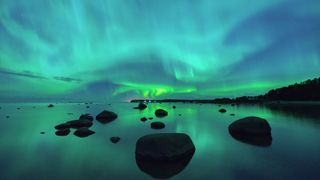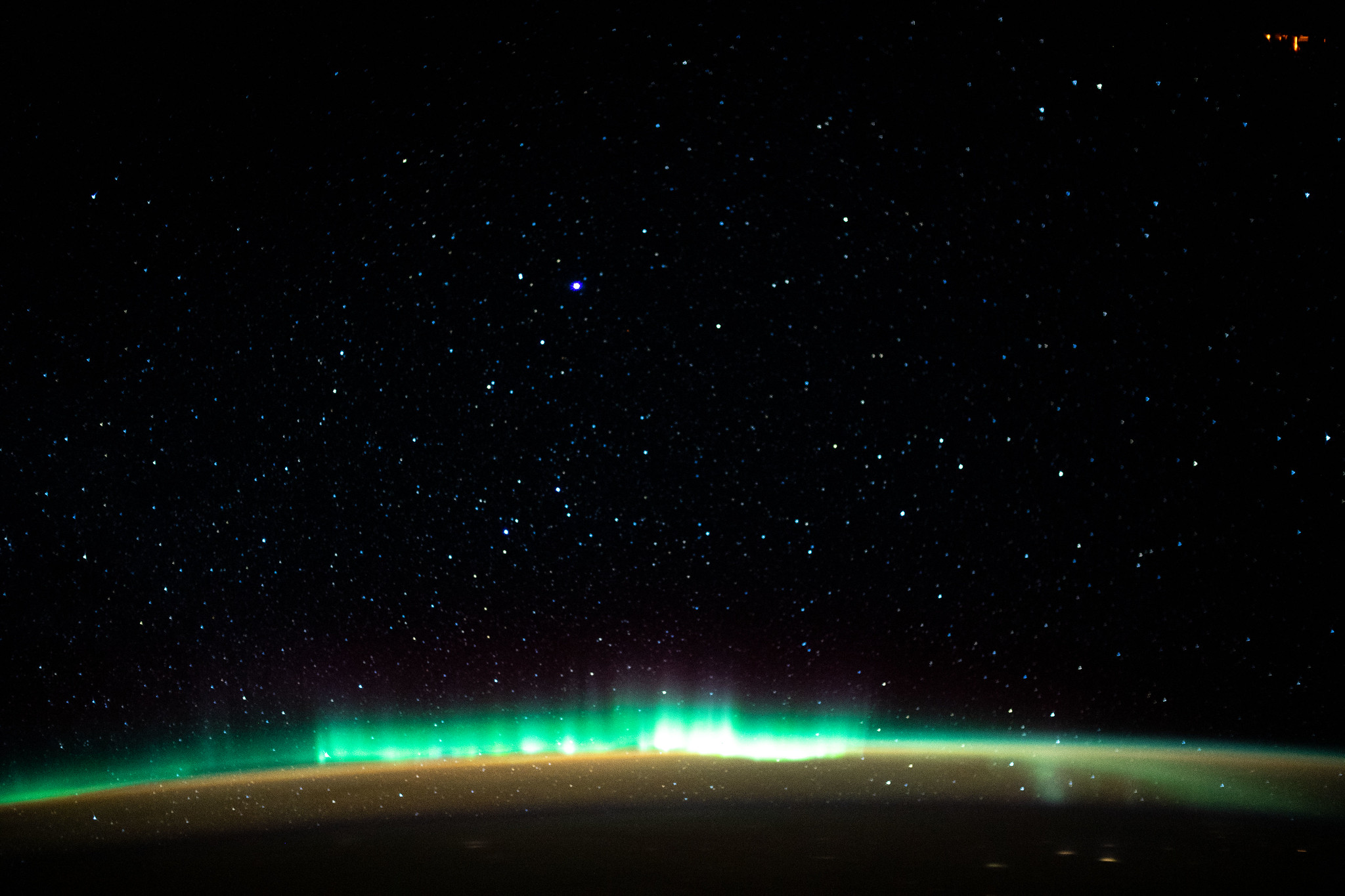Can the Northern Lights Be Different Colors
Northern lights (aurora borealis): What they are & how to see them

The northern lights, or the aurora borealis, are the beautiful dancing waves of light that have captivated people for millennia. But for all its beauty, this spectacular light show is a rather violent event.
Energized particles from the sun slam into Earth's upper atmosphere at speeds of up to 45 million mph (72 million km/h), but our planet's magnetic field protects us from the onslaught. As Earth's magnetic field redirects the particles toward the North Pole, the dramatic process transforms into a cinematic atmospheric phenomenon that dazzles and fascinates scientists and skywatchers alike.
The history of the northern lights
Though it was Italian astronomer Galileo Galilei who coined the name "aurora borealis" in 1619 — after the Roman goddess of dawn, Aurora, and the Greek god of the north wind, Boreas — the earliest suspected record of the northern lights is in a 30,000-year-old cave painting in France.
Since that time, civilizations around the world have marveled at the celestial phenomenon, ascribing all sorts of origin myths to the dancing lights. One North American Inuit legend suggests that the northern lights are spirits playing ball with a walrus head, while the Vikings thought the phenomenon was light reflecting off the armor of the Valkyrie, the supernatural maidens who brought warriors into the afterlife.
Early astronomers also mentioned the northern lights in their records. A royal astronomer under Babylon's King Nebuchadnezzar II inscribed his report of the phenomenon on a tablet dated to 567 B.C., while a Chinese report from 193 B.C. also notes the aurora, according to NASA.
The science behind the northern lights wasn't theorized until the turn of the 20th century. Norwegian scientist Kristian Birkeland proposed that electrons emitted from sunspots produced the atmospheric lights after striking the Earth's magnetic field. The theory would eventually prove correct, but not until long after Birkeland's death.

What are the northern lights?
At any given moment, the sun is ejecting charged particles from its corona, or upper atmosphere, creating what's called the solar wind. When that wind slams into Earth's ionosphere, or upper atmosphere, the aurora is born. In the Northern Hemisphere, the phenomenon is called the northern lights (aurora borealis), while in the Southern Hemisphere, it's called the southern lights (aurora australis).
"These particles are deflected towards the poles of Earth by our planet's magnetic field and interact with our atmosphere, depositing energy and causing the atmosphere to fluoresce," said Billy Teets, an astronomer and the director of Dyer Observatory at Vanderbilt University in Nashville, Tennessee.
The bright colors of the northern lights are dictated by the chemical composition of Earth's atmosphere. "Every type of atom or molecule, whether it's atomic hydrogen or a molecule like carbon dioxide, absorbs and radiates its own unique set of colors, which is analogous to how every human being has a unique set of fingerprints," Teets told Space.com. "Some of the dominant colors seen in aurorae are red, a hue produced by the nitrogen molecules, and green, which is produced by oxygen molecules."
While solar wind is constant, the sun's emissions go through a roughly 11-year cycle of activity. Sometimes there's a lull, but other times, there are vast storms that bombard Earth with extreme amounts of energy. This is when the northern lights are at their brightest and most frequent. The last solar maximum, or period of peak activity, occurred in 2014, according to the National Oceanic and Atmospheric Administration (NOAA), placing the next one in approximately 2025.
Despite plenty of advances in heliophysics and atmospheric science, much about the northern lights remains a mystery. For example, researchers weren't entirely sure how the energized particles in the solar wind accelerated to their extraordinary speeds (45 million mph) until June 2021, when a study published in the journal Nature Communications confirmed that a phenomenon called Alfvén waves gave the particles a boost. Alfvén waves are low-frequency yet powerful undulations that occur in plasma due to electromagnetic forces; the electrons that create the northern lights "surf" along these waves in the Earth's atmosphere, accelerating rapidly.
NASA is also on the hunt for clues about how the northern lights work. In 2018, the space agency launched the Parker Solar Probe, which is currently orbiting the sun and will eventually get close enough to "touch" the corona. While there, the spacecraft will collect information that could reveal more about the northern lights.

Are there other types of auroras?
On Earth, the northern lights' counterpart in the Southern Hemisphere is the southern lights — they are physically the same and differ only in their location. As such, scientists expect them to occur simultaneously during a solar storm, but sometimes the onset of one lags behind the other.
"One of the more challenging aspects of nightside aurorae involves the comparison of the aurora borealis with the aurora australis," said Steven Petrinec, a physicist at Lockheed Martin who specializes in magnetospheric and heliospheric physics. "While some auroral emissions occur in both hemispheres at the same magnetic local time, other emissions appear in opposing sectors in the two hemispheres at different times — for example, pre-midnight in the Northern Hemisphere and post-midnight in the Southern Hemisphere."
The hemispheric asymmetry of the aurora is in part due to the sun's magnetic field interfering with Earth's magnetic field, but research into the phenomenon is ongoing.
Another aurora-like occurrence on Earth is STEVE (Strong Thermal Emission Velocity Enhancement). Like the northern and southern lights, STEVE is a glowing atmospheric phenomenon, but it looks slightly different from its undulating auroral counterparts. "These emissions appear as a narrow and distinct arc, are typically purple in color and often include a green picket-fence structure that slowly moves westward," Petrinec told Space.com.
STEVE is also visible from lower latitudes, closer to the equator, than the auroras.
A 2019 study published in the journal Geophysical Research Letters discovered that STEVE is the result of two mechanisms: The mauve streaks are caused by the heating of charged particles in the upper atmosphere, while the picket-fence structure results from electrons falling into the atmosphere. The latter process is the same driver of the aurora, making STEVE a special kind of aurora hybrid.
Auroras occur on other planets, too — all that's required to make an aurora is an atmosphere and a magnetic field.
"Auroras have been seen in the atmospheres of all the gas giant planets, which is not surprising, since these planets all have robust magnetic fields," said Jeff Regester, an instructor of physics and astronomy at High Point University in North Carolina. "More surprisingly, auroras have also been discovered on both Venus and Mars, both of which have very weak magnetic fields."
Where and when to see the northern lights
Seeing the northern lights with your own eyes is a bucket-list item for astronomy lovers and travelers alike. Fortunately, they occur frequently. "The northern lights are happening 24 hours a day, seven days a week, 365 days a year," said photographer Chad Blakely, owner of northern lights tour company Lights Over Lapland. But that doesn't mean they're easy to spot; you need to be at the right place at the right time.
The best place to see the northern lights is any destination in the "auroral zone," the area within an approximately 1,550-mile (2,500 kilometers) radius of the North Pole, according to the Tromsø Geophysical Observatory. That's where the aurora most frequently occurs, though the phenomenon can creep farther south during particularly strong solar storms. Within the zone, it's best to be as far away from city lights as possible to maximize visibility. But it's pretty tricky to get into the middle of the Arctic wilderness, even with a guide, so it's best to base yourself in a destination with solid infrastructure, like Fairbanks, Alaska; Yellowknife, Canada; Svalbard, Norway; Abisko National Park, in Sweden; Rovaniemi, Finland; and pretty much anywhere in Iceland.
Related: Where to see the northern lights: 2021 aurora borealis guide
The best time of year to see the northern lights is between September and April, when the sky gets dark enough to see the aurora. (Northern locales experience the midnight sun, or 24 hours of daylight in the summer.) The most action usually happens between 9 p.m. and 3 a.m., according to the Geophysical Institute of the University of Alaska Fairbanks. Keep the moon phases in mind, as a bright full moon might fill the night sky with light. Check local weather forecasts as well, because you won't be able to spot the aurora through the clouds.
You can also monitor aurora forecasts from the University of Alaska Fairbanks' Geophysical Institute and NOAA, which offers both three-day and 30-minute forecasts.
Additional resources
- Read more about Kristian Birkeland in "The Northern Lights: The True Story of the Man Who Unlocked the Secrets of the Aurora Borealis" (Vintage, 2002), by Lucy Jago.
- Keep up to date on NASA's Parker Solar Probe mission by following the Parker Solar Probe blog.
- Watch livestreams of the northern lights via Explore.org.
Join our Space Forums to keep talking space on the latest missions, night sky and more! And if you have a news tip, correction or comment, let us know at: community@space.com.

Space.com contributing writer Stefanie Waldek is a self-taught space nerd and aviation geek who is passionate about all things spaceflight and astronomy. With a background in travel and design journalism, as well as a Bachelor of Arts degree from New York University, she specializes in the budding space tourism industry and Earth-based astrotourism. In her free time, you can find her watching rocket launches or looking up at the stars, wondering what is out there. Learn more about her work at www.stefaniewaldek.com.
Can the Northern Lights Be Different Colors
Source: https://www.space.com/15139-northern-lights-auroras-earth-facts-sdcmp.html